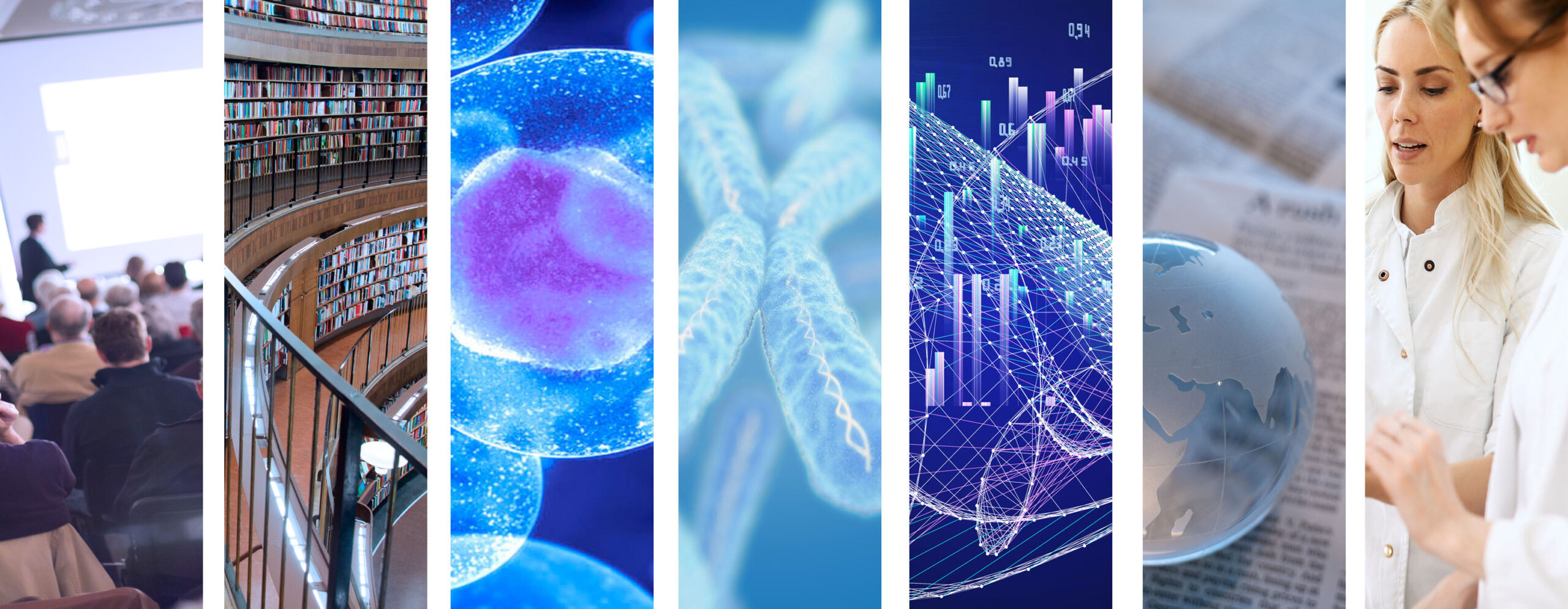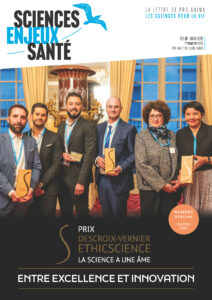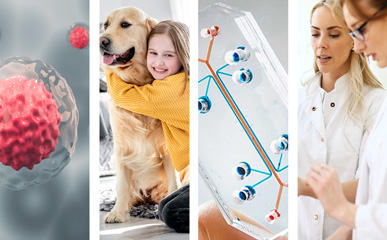
Imagining futures of 3D bioprinting by WHO, PrecisionTox Report on Socio-Technical Barriers, EFSA Podcast and more
News on non-animal methods
Feb. 12 - 16, 2024NEWS, REPORTS & POSITION STATEMENTS
1. Imagining futures of 3D bioprinting by WHO global health foresight series
The report presents the outcomes of a foresight project led by the Emerging Technologies, Research Prioritisation and Support unit and the Blood and Other Products of Human Origin team at the World Health Organization (WHO) on 3D bioprinting and global health. The project was conducted between August and November 2023.
3D bioprinting could be used to meet crucial public health challenges, such as the demand for repair or replacement of human organs and tissues. The foreseen applications of the technology include research, training and various medical uses. Outstanding issues include quality, safety, efficacy, equity of access and ethics, and appropriate regulations and governance should be considered to address those issues efficiently.
2. Read the Report on Socio-Technical Barriers to the Uptake of NAMs, by PrecisionTox
Over the past decade, considerable progress has been made in developing new approach methodologies (NAMs) for chemical risk assessment employing in vitro, in silico, and in chemico approaches, as well as the strategic use of alternative metabolic model organisms, to uncover the potential adverse effects of chemicals on human health and the environment.
In general, these NAMs have been welcomed not least because of a desire, reflected in the wider ethical views of society, to curtail the use of animals for toxicity testing. Additional potential benefits include greater predictive precision, lower testing costs, and faster testing processes. Nonetheless, obstacles remain, for example, in the form of doubts as to the reproducible and predictive capacity of NAMs and the ability of regulatory structures to accommodate these diverse methods.
3. EFSA Podcast : Beyond Animal Testing
“I think it’s already possible to reduce [animal testing], I would say at least by a significant amount. You could do targeted testing by identifying again using cell systems, even in animal cell systems and human cell systems, you could identify the targets, be it the liver, the thyroid, the lung, the kidney, and you could test that within human cell systems and let’s say on test species’ cell systems such as rats. Eventually if there is a need, a legislative need, to get an in-vivo study done then instead of having different studies, you could have a very targeted study and it could be just one. So that would be a reduction already of 90% of the testing.” — says Jean-Lou Dorne, Senior Scientific Officer in the Methodology and Scientific Support Unit at EFSA.
Listen to the podcast (14 min)
4. UW – Madison researchers first to 3D-print functional human brain tissue
A team of University of Wisconsin – Madison scientists has developed the first 3D-printed brain tissue that can grow and function like typical brain tissue.
The printing technique offers precision — control over the types and arrangement of cells — not found in brain organoids. The organoids grow with less organization and control. It’s an achievement with important implications for scientists studying the brain and working on treatments for a broad range of neurological and neurodevelopmental disorders, such as Alzheimer’s and Parkinson’s diseases.
Traditional printing methods have limited the success of previous attempts to print brain tissue, according to Su-Chun Zhang, professor of neuroscience and neurology, and Yuanwei Yan, a scientist in his lab. The group behind the new 3D-printing process described their method in the journal Cell Stem Cell.
INDUSTRY, BIOTECH & PARTNERSHIPS
5. Organ-on-a-chip : transforming drug development by Merck
When we are ill, most of us will rely on medicine to help us get better. But behind every drug is many years of thorough research – it takes an average of 12 years for a drug to travel from the laboratory to your medicine cabinet. The crux of the problem lies with traditional pre-clinical testing models – which involve human cells or animals – as these can only go so far towards predicting the effects of an experimental medicine on the human body.
The development of advanced cell culture models, such as ‘organ-on-a-chip’ technologies, can more accurately reflect human physiology and could potentially revolutionize the future of drug development.
The organ-on-a-chip technology is very complex, is constantly developing, and is being used by multiple industries for many different purposes. And so, collaboration is a key aspect for its success, requiring input from scientists working across several areas of research. “The hope is that these organ-on-a-chip technologies can one day help accelerate the development of new drugs and advance personalized medicine,” says Philip Hewitt, Merck’s Head of Early Investigative Toxicology.
6. New collaboration between Danaher and Cincinnati Children’s Hospital Medical Center to Improve Patient Safety in Early Drug Development
More than 20% of clinical trials fail due to drug-induced liver injury (DILI), leading to as much as $3 billion annually in lost effort. Widely used in vitro models for toxicity testing that rely on immortalized cell lines or primary cells frequently fall short in accurately predicting human responses such as DILI.
Molecular Devices, a Danaher subsidiary and leading high-performance life science solutions provider, will build on a long-standing relationship with Cincinnati Children’s to lead the Beacon’s work. Molecular Devices is a pioneer of end-to-end solutions for organoid development, and recently launched the CellXpress.ai™ Automated Cell Culture System – an AI-enabled solution that automates demanding production schedules to produce reliable, reproducible, and streamlined organoids at scale.
“This joint endeavor will bring together our collective expertise and aim to make strides in robust technology with the potential to impact countless patients waiting for safe new drugs.” — Takanori Takebe, MD, PhD, Director for Commercial Innovation at CuSTOM and an associate professor in the University of Cincinnati Department of Pediatrics
7. How 3D human tissue models are transforming drug discovery, Q&A with Keith Murphy, CEO of Organovo
Adoption of 3D human tissue models will help reduce the number of failed clinical trials because ineffective drugs are weeded out pre-clinically. By using 3D human tissue models, patients in clinical trials will be exposed to fewer ineffective drugs, reducing their risk of side effects without any benefit.
Among his many insights, Keith Murphy details the limitations of animal models, how Organovo’s 3D human tissue models facilitate a deeper understanding of genetic expression within specific diseases, and how widespread adoption of these models will enable rapid drug target identification, reduce cost and decrease toxicity.
8. How digital innovation is helping therapeutics to get to market faster
From finding potential active substances and identifying novel targets, to simulating how drugs will function in the human body and optimising laboratory workflows, digital technologies are having a significant impact on drug discovery and development.
There are a number of companies leading the charge in applying innovative technologies, particularly artificial intelligence (AI) and machine learning (ML), to the search for new medicines.
Biopharma and biotech companies without these capabilities are keen to harness these technologies and the number of strategic partnerships with such companies is accelerating at an unprecedented rate. Sanofi has stated that it intends to become the first pharma company “powered by AI at scale”, and as part of this ambition, agreed a collaboration with BioMap to co-develop advanced AI models and protein Large Language Models that it hopes will enable biologics design and multiparametric optimisation.
9. Defining hallmarks of stem cells
A new review from Roche’s Institute of Human Biology and Roche Pharma Research and Early Development (pRED) describes stem cells’ unique and shared features, laying the foundation of what is known in the stem cell universe and mapping new approaches in drug discovery.
Understanding stem cells matters not only because they are part of our bodies, but also because they are key to an important technology that benefits patients : organoid models.
“Every step of drug discovery where you would use mice or human cell lines, you can use organoids, and they’re often even better than traditional models. They hold the promise of modeling every human disease in the lab.” Hans Clevers Head of Pharma Research and Early Development at Roche.
SCIENTIFIC DISCOVERIES & PUBLICATIONS
10. The Promise and Potential of Brain Organoids by Lena Smirnova, Thomas Hartung
Brain organoids are three-dimensional in vitro culture systems derived from human pluripotent stem cells that self-organize to model features of the (developing) human brain. This review examines the techniques behind organoid generation, their current and potential applications, and future directions for the field.
Brain organoids possess complex architecture containing various neural cell types, synapses, and myelination. They have been utilized for toxicology testing, disease modeling, infection studies, personalized medicine, and gene-environment interaction studies. An emerging concept termed Organoid Intelligence (OI) combines organoids with artificial intelligence systems to generate learning and memory, with the goals of modeling cognition and enabling biological computing applications. Brain organoids allow neuroscience studies not previously achievable with traditional techniques, and have potential to transform disease modeling, drug development, and our understanding of human brain development and disorders. The aspirational vision of OI parallels the origins of artificial intelligence, and efforts are underway to map a roadmap toward its realization. In summary, brain organoids constitute a disruptive technology that is rapidly advancing and gaining traction across multiple disciplines.
11. Towards single-cell bioprinting : micropatterning tools for organ-on-chip development
While the organ-on-chip (OoC) field has rapidly evolved with the integration of sophisticated microengineered designs, development of microenvironmental control and sensing capabilities, it is still lagging behind in terms of achieving natural tissue microarchitecture, which is imperative for its actual function. 3D (bio)printing techniques are increasingly used for the fabrication of OoCs, due to either the rapid-prototyping capabilities for chip fabrication or the ability to integrate tissue microarchitecture.
This review emphasizes the need to include microarchitectural and microstructural features, and discusses promising avenues to incorporate well-defined microarchitectures down to the single-cell level. The researchers highlight how their integration will significantly contribute to the advancement of the field towards highly organized structural and hierarchical tissues-on-chip. They also discuss the combination of state-of-the-art micropatterning technologies to achieve OoCs resembling human-intrinsic complexity, anticipating that these innovations will yield significant advances in realization of the next generation of OoC models.


